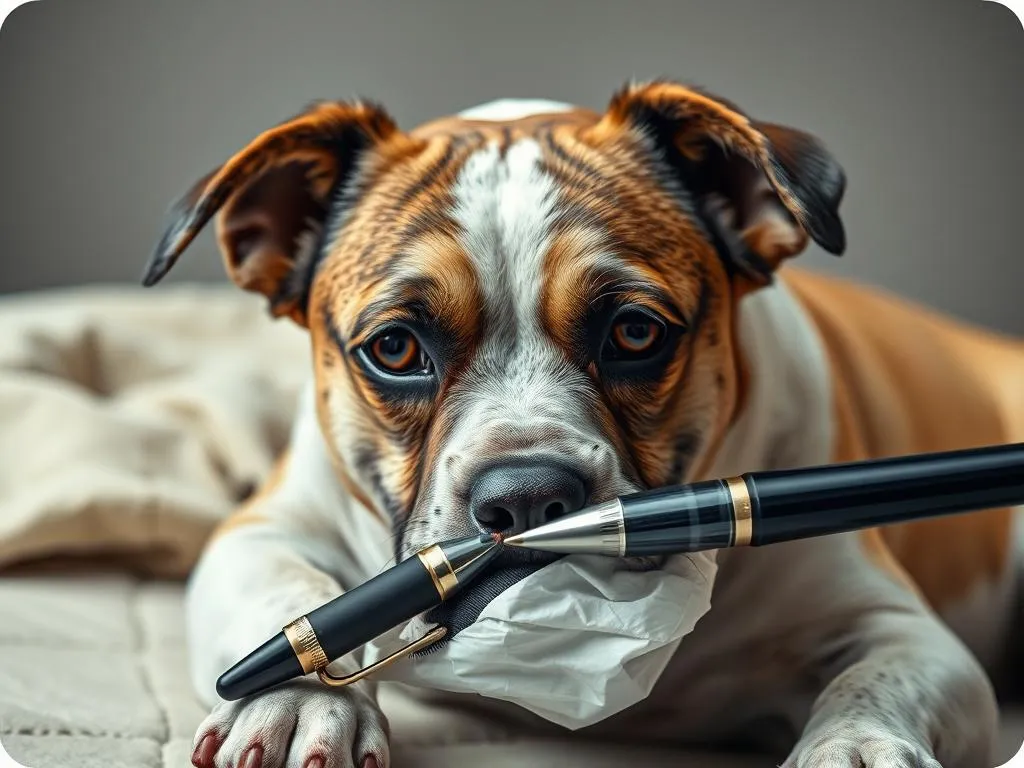
Introduction
Dogs are notorious for their curious nature, often leading them to ingest a variety of foreign objects. While most pet owners are familiar with the dangers of common items like toys or food wrappers, the case of a dog eating an ink pen presents a unique set of concerns. This situation can be alarming, and it raises immediate questions about the health risks involved and the necessary actions to take.
When your furry friend has consumed something they shouldn’t have, it’s crucial to seek professional veterinary guidance. The consequences of ingesting foreign objects can be severe, ranging from physical injuries to toxic reactions. Understanding how to respond effectively can make a significant difference in your dog’s health outcomes.
Understanding the Risks of Ingesting Foreign Objects
Common Foreign Objects Dogs Ingest
Dogs often find themselves munching on items that pique their interest. Some of the more common foreign objects include:
- Toys (especially small, chewable parts)
- Food wrappers and packaging
- Bones and rawhide chews
- Socks and clothing
However, ink pens stand out as a particularly concerning foreign object due to their unique composition. An ink pen typically contains plastic, metal, and ink, all of which pose various risks to your dog’s health.
Potential Health Risks
The ingestion of an ink pen can lead to several potential health risks, including:
- Choking: The pen can become lodged in your dog’s throat, leading to suffocation.
- Intestinal Obstruction: If the pen passes through the stomach, it can cause a blockage in the intestines, which can be life-threatening if not addressed.
- Chemical Risks: The ink and plastic components may contain toxic substances that can lead to poisoning or gastrointestinal irritation.
Symptoms to Look For
After a dog has ingested an ink pen, it’s vital to monitor their behavior closely. Signs of distress may include:
- Vomiting or retching
- Lethargy or decreased energy
- Excessive drooling
- Abdominal pain (indicated by whining or unusual postures)
If your dog exhibits any of these symptoms, it’s essential to act quickly and consult a veterinarian.
Immediate Actions to Take
Assessing the Situation
The first step after your dog has eaten an ink pen is to assess the situation. Ask yourself:
- When did the incident occur?
- What specific parts of the pen were ingested (e.g., the whole pen, just the ink cartridge)?
- How is your dog behaving right now?
Gathering this information will be crucial for the veterinarian.
When to Contact a Veterinarian
Certain symptoms or situations require immediate veterinary attention. You should contact your vet if:
- Your dog is showing any signs of choking or distress.
- They appear lethargic or unresponsive.
- You’re uncertain about the amount of the pen ingested.
When you call the vet, be prepared to answer questions such as:
- What type of ink pen did your dog eat?
- How long ago did this happen?
- Is your dog exhibiting any concerning symptoms?
Do Not Do’s
In the heat of the moment, it’s easy to make mistakes. Avoid these common missteps:
- Do not induce vomiting without veterinary guidance, as it may lead to further complications.
- Do not wait too long before seeking help, as the risks can escalate quickly.
- Do not give any home remedies without consulting a veterinarian first.
Veterinary Examination and Diagnosis
What to Expect at the Vet’s Office
When you arrive at the vet’s office, the first step will be a thorough physical examination. The veterinarian will check your dog’s vital signs and assess their overall condition. It’s important to provide them with all the details surrounding the incident, including the time of ingestion and any symptoms you’ve observed.
Diagnostic Tests
Depending on your dog’s condition, the vet may recommend various diagnostic tests to determine the severity of the situation. Common tests include:
- X-rays: These can help visualize whether the pen is causing an obstruction in the gastrointestinal tract.
- Ultrasounds: In some cases, an ultrasound may be used to get a clearer view of the internal organs and assess any damage.
These tests are vital for creating a treatment plan tailored to your dog’s specific needs.
Treatment Options
Possible Treatments for Ingested Ink Pen
The treatment for a dog that has eaten an ink pen can vary based on the situation. Possible approaches include:
-
Observation: If the pen has not caused any immediate distress and there are no signs of obstruction, the vet might recommend monitoring your dog closely at home.
-
Inducing Vomiting: If the ingestion was recent and the vet deems it safe, they may suggest inducing vomiting to expel the foreign object.
-
Surgical Intervention: In cases where the pen is stuck or causing a blockage, surgery may be necessary to remove it. This is typically a last resort but can be critical for your dog’s health.
Follow-up Care
After treatment, follow-up care is essential. The vet may provide specific instructions regarding:
- Diet: You may need to adjust your dog’s diet for a few days to ease digestion.
- Monitoring: Keep a close eye on your dog for any signs of complications, such as vomiting, diarrhea, or lethargy.
- Follow-up appointments: Depending on the severity of the situation, a follow-up visit may be required to ensure your dog is recovering properly.
Prevention Strategies
Understanding Canine Behavior
To prevent future incidents, it’s important to understand why dogs chew and ingest foreign objects. Dogs often explore the world with their mouths, and curiosity can lead them to pick up anything within reach. Boredom, anxiety, or lack of exercise can also drive dogs to chew on inappropriate items.
Preventing Future Incidents
To decrease the likelihood of your dog ingesting foreign objects like ink pens, consider the following strategies:
- Safe Storage: Store household items, including pens and other small objects, out of your dog’s reach.
- Dog-proofing: Conduct a thorough sweep of your home to identify and eliminate potential hazards.
- Engagement: Provide plenty of toys and activities to keep your dog mentally and physically stimulated.
Implementing these strategies can create a safer environment for your furry friend and reduce the chances of ingesting foreign objects in the future.
Conclusion
In summary, the ingestion of an ink pen by your dog can pose serious health risks that require immediate attention. Understanding the potential dangers, recognizing symptoms, and knowing when to seek veterinary help can help ensure your dog’s safety.
As a pet owner, it’s essential to remain vigilant and proactive in preventing such incidents. Regular vet check-ups and open communication with veterinary professionals can significantly contribute to your pet’s overall health and well-being. Remember, you’re not alone in this journey—many pet owners face similar challenges, and there are resources available to help navigate these situations.
Frequently Asked Questions (FAQs)
What should I do if my dog eats something else?
If your dog ingests another foreign object, assess the situation similarly to when they ate the ink pen. Monitor their behavior and symptoms, and contact your veterinarian. Provide as much detail as possible to help the vet determine the best course of action.
How can I tell if my dog is in pain after swallowing a foreign object?
Signs that your dog may be in pain include whining, restlessness, refusal to eat, or unusual postures (such as lying in a curled position). If you notice any of these symptoms, it’s crucial to seek veterinary care immediately.
By being informed and prepared, you can effectively respond to situations involving ingested foreign objects and keep your furry companion safe and healthy.









